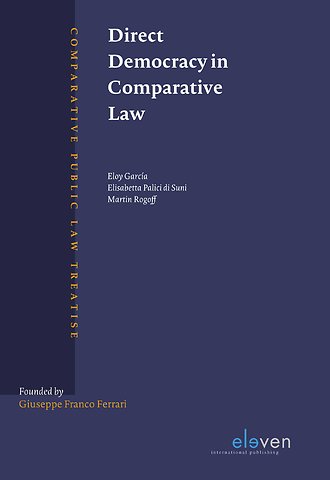


Elisabetta Palici di Suni is Professor of Public Comparative Law, University of Torino, Department of Law.
Meer over de auteursDirect Democracy in Comparative Law
(PDF-Download)
E-book Pdf met watermerkbeveiliging Engels 2018 1e druk 9789462748491Samenvatting
Faced with the variety and complexity of the forms that direct democracy takes today, this book pays attention first to the main stages in which direct democracy has historically evolved, and then considers at greater length the systems currently in place in different countries.
The first chapter provides historical background. The two following chapters are devoted to Europe and to the Americas, where direct democracy is most developed. The analysis of the different forms that direct democracy has historically taken and those that characterize contemporary systems should allow a more balanced judgment for or against direct democracy, both in general and in specific contexts.
The Comparative Public Law Treatise is a comprehensive body of publications, addressing the most relevant topics within comparative public law. The Treatise aims to identify and present in an original fashion comparative knowledge in the area of public law, whilst also developing new interpretative guidelines. Each volume, which is written by reputable scholars, offers a specialised analysis, which will be of use to legal scholars, students and also general readers.
Trefwoorden
directe democratie constitutioneel recht vergelijkend recht referendum politiek politieke participatie democratie grondwet volksinitiatieven europees recht representatieve democratie zwitserland politieke systemen verenigde staten politieke theorie volksraadpleging spanje duitsland europese unie burgerparticipatie italië geschiedenis frankrijk
Trefwoorden
Specificaties
Lezersrecensies
Over Martin Rogoff
Over Eloy Garcia
Inhoudsopgave
U kunt van deze inhoudsopgave een PDF downloaden
Acknowledgements xiii
1 The Historical Evolution of Direct Democracy 1
1.1 Introduction 1
1.1.1 The Explosion of Direct Democracy in Contemporary Systems 1
1.1.2 Arguments against and for Direct Democracy 2
1.1.3 The Instruments of Direct Democracy 5
1.1.4 The Origins of Direct Democracy: From Antiquity to the Swiss Cantons 11
1.2 The Period of Democratic Revolutions and the Nineteenth Century in France and the United States 13
1.2.1 The United States 15
1.2.1.1 The American Colonies 17
1.2.1.2 The Revolutionary Period: Declaration of Independence, State Constitutions, Articles of Confederation, the Federalist Papers, and the United States Constitution 21
1.2.1.3 The ‘Revolution of 1800’ and ‘Jacksonian Democracy’ (1829-1841) 26
1.2.1.4 The Progressive Movement 30
1.2.1.5 Direct Democracy in Oregon 36
1.2.2 France 38
1.2.2.1 L’ancien Régime 38
1.2.2.2 Les Lumières: Montesquieu and Rousseau 40
1.2.2.3 The Revolutionary Period: Sieyès, Revolutionary Constitutions and Les San-culottes 43
1.2.2.4 The Heritage of Bonapartism: Plebiscitary Democracy 47
1.2.2.5 The Nineteenth Century: The Republic Submerged, Under Siege, and Triumphant 48
1.2.2.6 Departmental and Local Levels 51
1.3 Direct Democracy in the Italian Risorgimento and European post-World War I Constitutions 52
1.3.1 The Spanish Constitution of 1931 59
1.4 Plebiscites and Direct Democracy in authoritarian regimes 61
1.4.1 Direct Democracy during Nazism and Fascism 61
1.4.2 Direct Democracy during the Franco Period 63
2 Referendum and Direct Democracy in Europe 67
2.1 France 67
2.1.1 The Power of Initiative 68
2.1.2 The National Referendum in the Constitution of 1958 70
2.1.2.1 The Legislative Referendum 70
2.1.2.2 The Constituent Referendum 72
2.1.2.3 The Referendum in the International Domain 72
2.1.3 The National Referendum in Action 72
2.1.4 The Local Referendum 74
2.1.5 Participative Democracy and Neighbourhood Democracy 76
2.2 Italy 79
2.2.1 The Referendum in the Constituent Assembly 79
2.2.2 The Troubled Implementation of Referendums in Italy 88
2.2.3 Constitutional Referendums and Regional Referendums 97
2.3 Germany 102
2.3.1 The Choice for Representative Democracy 102
2.3.2 The Referendum for Territorial Changes of the Länder 103
2.3.3 Direct Democracy in the Länder 109
2.3.4 Current Trends 112
2.4 Spain 114
2.4.1 Setting the Stage: the Political Significance of Direct Democracy and the Equivocal Treatment of the Referendum by the Spanish Legislature 114
2.4.2 The Institutions of Direct Democracy in the Process of Drafting the Constitution: The Referendum and the Popular Legislative Initiative. The Legislative Process 118
A The constitutional procedure of Article 92 CE in the work of the Constituent Assembly and the different types of referendum. 118
B The popular legislative popular initiative 126
2.4.3 The Practice of the Referendum in Spanish Political Life. Current Problems of the Referendum in Spain: “Right to decide” and Democracy; its Political Implications for the Mass Society 128
2.4.3.1 Referendum and Political Debate 128
2.4.3.2 The Current Problems of the Referendum in Spain: ‘The Right to Decide and Democracy’ 130
2.4.4 The Catalan Question 143
2.5 Other European Countries 145
2.5.1 The Referendum in Other European Countries 145
2.5.2 The Popular Initiative in Europe 160
2.5.2.1 The Popular Initiative in European Countries 160
2.5.2.2 The Popular Initiative in the European Union 160
3 Referendum and Direct Democracy in America 165
3.1 The United States 165
3.1.1 Revival of Direct Democracy 165
3.1.2 The Initiative and Referendum 167
3.1.3 Recall 169
3.1.4 Direct Democracy at the Local Level 173
3.1.5 Direct Democracy in the Courts 176
3.1.6 Direct Democracy in California 184
3.1.7 Direct Democracy in the Electronic Age 189
3.2 Canada 191
3.2.1 Democracy and Government in Canada: English and French Backgrounds, the Parliamentary Tradition, ‘Representative’ and ‘Responsible’ Government 191
3.2.2 Direct Democracy at the National Level 199
3.2.3 Quebec: la société distincte 202
3.2.4 Direct Democracy at the Provincial Level 205
3.2.5 Direct Democracy at the Municipal Level 207
3.3 Latin America 209
3.3.1 Introduction 209
3.3.2 The Right to Participate in the Constitution, Exercise and Control of Political Power 211
3.3.3 Popular Exercise of Political Power 214
3.3.4 The Popular Control of Political Power 222
3.3.5 The Experience of the Republic of Colombia 223
3.3.6 Conclusions 234
Anderen die dit e-book kochten, kochten ook
Rubrieken
- advisering
- algemeen management
- coaching en trainen
- communicatie en media
- economie
- financieel management
- inkoop en logistiek
- internet en social media
- it-management / ict
- juridisch
- leiderschap
- marketing
- mens en maatschappij
- non-profit
- ondernemen
- organisatiekunde
- personal finance
- personeelsmanagement
- persoonlijke effectiviteit
- projectmanagement
- psychologie
- reclame en verkoop
- strategisch management
- verandermanagement
- werk en loopbaan





